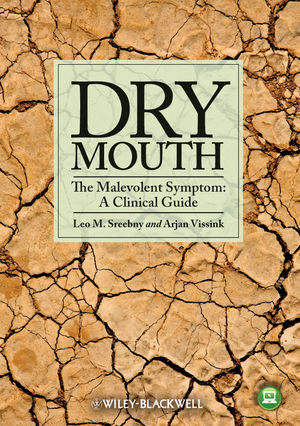
Dry Mouth, The Malevolent Symptom
Wiley-Blackwell (Verlag)
978-0-8138-1623-4 (ISBN)
Xerostomia, more commonly called dry mouth, affects an estimated 20 percent of adults worldwide and can severely diminish one’s quality of life. Dry Mouth, the Malevolent Symptom: A Clinical Guide relies on evidence-based research to provide an introductory primer on oral dryness and the modalities available to treat it. The book describes the varied etiology of the disease, but emphasizes clinical protocols and step-by-step procedures for diagnosis and treatment planning. Dry Mouth is a user-friendly manual guiding clinicians through identifying and managing this common condition. Causes including radiotherapy, chemotherapy, systemic diseases, polypharmacy, and the natural progression of aging are discussed in conjunction with the clinical symptoms and signs associated with each one. Multiple avenues for treatment are presented, highlighting salivary stimulation and supplementation techniques, pharmacologic aids, and critically required oral therapy. Although intended primarily for the professionals that treat those affected by xerostomia, Dry Mouth may also be of interest to sufferers of this condition.
Leo M. Sreebny is Professor Emeritus at Stony Brook University in New York and Affiliate Professor at the University of Washington in Seattle. Arjan Vissink is Professor of Oral Medicine at the University Medical Center Groningen in the Netherlands.
Preface. Acknowledgments.
Introduction (Olav Alvares)
In memoriam: Jonathan Ship (1959–2008)—a celebration of his life
Editors and contributors
1. The enigma of dry mouth.
1.1 Dry mouth: a common worldwide tormentor (L.M. Sreebny).
1.2 Saliva: the remarkable fluid (A. van Nieuw Amerongen, E.C.I. Veerman and A. Vissink).
1.3 Living with the drought: the patient speaks (K. Morland Hammitt).
2. Dry mouth: a multifaceted diagnostic dilemma.
2.1 The odd couple: dry mouth and salivary flow (L.M. Sreebny).
2.2 Symptoms and semiotics (A. Vissink and L.M. Sreebny).
2.3 Sialometry: the measure of things, with ease and reliability (L.M. Sreebny and A. Visink).
2.4 Other ways to assess salivary gland disease (A. Vissink).
3. The causes of dry mouth: a broad panoply.
3.1 Drugs, dry mouth and dentistry (L.M. Sreebny).
3.1.1. Setting the stage.
3.1.2. Drugs and the salivary system.
3.1.3. Xerogenic drugs.
3.1.4. Detailed reference guide to drugs and dry mouth.
3.2 Dry Mouth: diseases and conditions.
3.2.1 The auto-immune connection (C.G.M. Kallenberg).
3.2.2 Head and neck radiotherapy: an iatrogenic factor (A. Eisbruch).
3.2.3 Brains and saliva (E.C.I. Veerman and J.A. Bosch).
3.2.4 Other causes of dry mouth: the list is endless (S. Beier Jensen, A.M. Lynge Pedersen and B. Nauntofte).
4. Treating dry mouth: help is available (J. Ship, A. Vissink and L.M. Sreebny).
5. And what about the future?
5.1 Is gene therapy the answer? (B.J. Baum, C. Zheng, L. McCullagh, A.P. Cotrim, J.S. Brahim, J.C. Atkinson, C.M. Goldsmith, N.P. Nikolov, R.J. Turner and G.G. Illei).
5.2 Is stem cell therapy a reasonable approach? (R.P. Coppes and I. Lombaert).
7. Index.
| Verlagsort | Hoboken |
|---|---|
| Sprache | englisch |
| Maße | 190 x 246 mm |
| Gewicht | 651 g |
| Themenwelt | Medizin / Pharmazie ► Zahnmedizin |
| ISBN-10 | 0-8138-1623-8 / 0813816238 |
| ISBN-13 | 978-0-8138-1623-4 / 9780813816234 |
| Zustand | Neuware |
| Haben Sie eine Frage zum Produkt? |
aus dem Bereich


